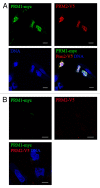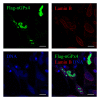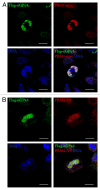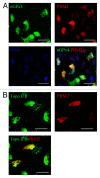The nuclear form of glutathione peroxidase 4 colocalizes and directly interacts with protamines in the nuclear matrix during mouse sperm chromatin assembly
- PMID: 25225625
- PMCID: PMC4160342
- DOI: 10.4161/spmg.28460
The nuclear form of glutathione peroxidase 4 colocalizes and directly interacts with protamines in the nuclear matrix during mouse sperm chromatin assembly
Abstract
The testis-specific nuclear form of Phospholipid Hydroperoxide Glutathione Peroxidase (nGPx4) is associated with the nuclear matrix during spermiogenesis and is implicated in sperm chromatin condensation. In this study, we have addressed the question whether nGPx4 directly interacts with protamines by transiently sharing a nuclear matrix localization. We first expressed tagged protamine 1-myc and protamine 2-V5 in HeLa and COS-1 cells and showed by both confocal microscopy and immunoblotting analyses that protamines were produced in vitro and colocalized correctly to the nucleus. Co-transfection experiments demonstrated that protamine 1 was physically associated with flag-nGPx4 specifically at the level of nuclear matrix. The peculiar presence of protamines together with nGPx4 in this subnuclear compartment was also confirmed in mouse elongated spermatids by immunofluorescence, suggesting that nGPx4 is a physiological component of a novel protein complex relevant to chromatin assembly in condensing haploid cells. Also, in epididymal sperm, nGPx4 and protamine 1 co-immunoprecipitated, indicating that nGPx4, although localized to a subnuclear compartment different from that of protamines, represents a constant link between nuclear matrix and chromatin in mammalian male gamete.
Keywords: heterologous expression; nGPx4; nuclear matrix; protamines; sperm chromatin assembly.
Figures








Similar articles
-
The nuclear form of glutathione peroxidase 4 is associated with sperm nuclear matrix and is required for proper paternal chromatin decondensation at fertilization.J Cell Physiol. 2012 Apr;227(4):1420-7. doi: 10.1002/jcp.22857. J Cell Physiol. 2012. PMID: 21618532
-
Involvement of sperm acetylated histones and the nuclear isoform of Glutathione peroxidase 4 in fertilization.J Cell Physiol. 2018 Apr;233(4):3093-3104. doi: 10.1002/jcp.26146. Epub 2017 Sep 20. J Cell Physiol. 2018. PMID: 28802016
-
Sperm chromatin protamination: an endocrine perspective.Protein Pept Lett. 2011 Aug;18(8):786-801. doi: 10.2174/092986611795714005. Protein Pept Lett. 2011. PMID: 21443490 Review.
-
Sperm nuclei glutathione peroxidases and their occurrence in animal species with cysteine-containing protamines.Biochim Biophys Acta. 2007 Oct;1770(10):1459-67. doi: 10.1016/j.bbagen.2007.07.009. Epub 2007 Jul 27. Biochim Biophys Acta. 2007. PMID: 17714875
-
Sperm nuclear protamines: A checkpoint to control sperm chromatin quality.Anat Histol Embryol. 2018 Aug;47(4):273-279. doi: 10.1111/ahe.12361. Epub 2018 May 23. Anat Histol Embryol. 2018. PMID: 29797354 Review.
Cited by
-
Inactivity of Peptidase ClpP Causes Primary Accumulation of Mitochondrial Disaggregase ClpX with Its Interacting Nucleoid Proteins, and of mtDNA.Cells. 2021 Nov 29;10(12):3354. doi: 10.3390/cells10123354. Cells. 2021. PMID: 34943861 Free PMC article.
-
Sperm Differentiation: The Role of Trafficking of Proteins.Int J Mol Sci. 2020 May 24;21(10):3702. doi: 10.3390/ijms21103702. Int J Mol Sci. 2020. PMID: 32456358 Free PMC article. Review.
-
The subcellular location of selenoproteins and the impact on their function.Nutrients. 2015 May 22;7(5):3938-48. doi: 10.3390/nu7053938. Nutrients. 2015. PMID: 26007340 Free PMC article. Review.
-
TMT-Based Proteomic Analysis of Human Spermatozoa from Unexplained Recurrent Miscarriage Patients before and after Oral Antioxidant Treatment.Biomedicines. 2022 Aug 19;10(8):2014. doi: 10.3390/biomedicines10082014. Biomedicines. 2022. PMID: 36009561 Free PMC article.
-
Proteomic Signatures in Spermatozoa Reveal the Role of Paternal Factors in Recurrent Pregnancy Loss.World J Mens Health. 2020 Jan;38(1):103-114. doi: 10.5534/wjmh.190034. Epub 2019 Jul 3. World J Mens Health. 2020. PMID: 31385471 Free PMC article.
References
-
- Carrell DT, Liu L. Altered protamine 2 expression is uncommon in donors of known fertility, but common among men with poor fertilizing capacity, and may reflect other abnormalities of spermiogenesis. J Androl. 2001;22:604–10. - PubMed
-
- Ramos L, van der Heijden GW, Derijck A, Berden JH, Kremer JA, van der Vlag J, de Boer P. Incomplete nuclear transformation of human spermatozoa in oligo-astheno-teratospermia: characterization by indirect immunofluorescence of chromatin and thiol status. Hum Reprod. 2008;23:259–70. doi: 10.1093/humrep/dem365. - DOI - PubMed
LinkOut - more resources
Full Text Sources
Other Literature Sources
